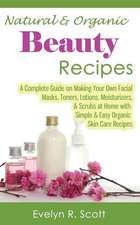Beauty Junkies: In search of the thinnest thighs, perkiest breasts, smoothest faces, whitest teeth, and skinniest, most perfect toes in America
Autor Alex Kuczynskien Limba Engleză Paperback – 14 ian 2008
Americans are aging faster and getting fatter than any other population on the planet. At the same time, our popular notions of perfect beauty have become so strict it seems even Barbie wouldn’t have a chance of making it into the local beauty pageant.
Aging may be a natural fact of life, but for a growing number of Americans its hallmarks—wrinkles, love handles, jiggling flesh—are seen as obstacles to be conquered on the path to lasting, flawless beauty. In Beauty Junkies Alex Kuczynski, whose sly wit and fearless reporting in the Times has won her fans across the country, delivers a fresh and irresistible look at America's increasingly desperate pursuit of ultimate beauty by any means necessary.
From a group of high-maintenance New York City women who devote themselves to preserving their looks twenty-four hours a day, to a “surgery safari” in South Africa complete with “after” photographs of magically rejuvenated patients posing with wild animals, to a podiatrist's office in Manhattan where a “foot face-lift” provides women with the right fit for their $700 Jimmy Choos, Kuczynski portrays the all-American quest for self-transformation in all its extremes. In New York, lawyers become Botox junkies in an effort to remain poker-faced. In Los Angeles, women of an uncertain age nip and tuck their most private areas, so that every inch of their bodies is as taut as their lifted faces. Across the country, young women graduating from high school receive gifts of breast implants – from their parents.
As medicine and technology stretch the boundaries of biology, Kuczynski asks whether cosmetic surgery might even be part of human evolution, a kind of cosmetic survival of the fittest – or firmest? With incomparable portraits of obsessive patients and the equally obsessed doctors who cater to their dreams, Beauty Junkies examines the hype, the hope, and the questionable ethics surrounding the advent of each new miraculous technique. Lively and entertaining, thought-provoking and disturbing, Beauty Junkies is destined to be one of the most talked-about books of the season.
Preț: 110.60 lei
Nou
Puncte Express: 166
Preț estimativ în valută:
21.16€ • 22.20$ • 17.62£
21.16€ • 22.20$ • 17.62£
Carte disponibilă
Livrare economică 11-25 martie
Preluare comenzi: 021 569.72.76
Specificații
ISBN-13: 9780767914116
ISBN-10: 0767914112
Pagini: 290
Dimensiuni: 132 x 203 x 23 mm
Greutate: 0.32 kg
Editura: Crown Publishing Group
Colecția Harmony
ISBN-10: 0767914112
Pagini: 290
Dimensiuni: 132 x 203 x 23 mm
Greutate: 0.32 kg
Editura: Crown Publishing Group
Colecția Harmony
Notă biografică
ALEX KUCZYNSKI, a reporter for the New York Times for eight years, is now a columnist for the Styles section. She has written for the Times on such wide-ranging topics as Botox, Britney Spears, and Buddhism, and her work has also appeared in Vanity Fair, Harper’s Bazaar, Allure, the New York Times Book Review, and the New York Times Magazine, among others. She lives in New York City.
Extras
A friend of mine, a New York entertainment executive in her fifties, does not look her age. She’s got the reedy, semistarvedbody of an adolescent, and she has avoided the sun with a fervor bordering on religious principle. She’s always impeccably turned out; she’s obsessed with shoes stilettos, kitten heels, anything to add a supple, curvaceous tightness to the calf muscle.
On a good day, she could pass for thirty - five - in dim light, possibly twenty-five.There are no telltale signs of age on her face, no wrinkles and no age spots. A dusky pink sheen illuminates her lips at all times, the work of a tattoo artist expert in the application of permanent makeup.
At the beginning of the summer, every year,my friend visits Dr.Patricia Wexler, a New York dermatologist whose clients have included Ellen Barkin,Donna Karan, Barbra Streisand, and Sean
"Diddy” Combs. Everyone who goes to Wexler or who has heard of her calls her “Dr.Pat.”
Prior to this visit, Dr.Pat has withdrawn fat from my friend’s buttocks and siphoned out enough fat to fill twelve thick vials. The vials are labeled and stored in a freezer along with fat suctioned out of dozens of famous actors and actresses, Dallas housewives, lawyers, television anchors. My friend wears a tightfitting set of Ace bandages for a week after the procedure. An opening at the bottom allows her to perform bodily functions and gives the outfit a distinctly S&M, Helmut Newton affect.
To subject oneself to the ministrations of a New York dermatologist can be a pricey prospect. Just to sit down and talk to Dr. Pat is $500. Laser treatments can run as high as $6,000 and liposuction as much as $11,000. A frequent guest on Oprah and the Today show, she has touted skin tightening procedures like Thermage (about $3,500, according to the New York Times).
Certainly, a patient won’t try everything at once. In the case of my friend and her fat, Iwatched Dr.Pat bring out one of the vials of fat and, using a fine subcutaneous needle, inject the contents of one of the syringes into the woman’s cheeks and nasolabial folds the lines that run from the nose to the mouth. The fat was surprisingly thick and bright yellow, a neon sludge that looks almost exactly like the lemon flavored cake frosting you might buy in a plastic Betty Crocker tub at the supermarket. Just greasier.
The procedure is called autologous fat transfer - that is,moving fat from one part of the body to another. Peggy Siegal, a public relations executive in New York who is also a patient of Dr. Pat’s, loves to joke about having had the procedure.
Siegal explains it this way: “The older you get, the more the fat gravitates to your butt. The doctor takes it out of your bottom and puts it back in your face. So when you are kissing my face, you are actually kissing my ass.” Then she gives a laugh, and it is a triumphant sound.
* * *
When Kathleen Kelly Cregan left her home in Croom,County Cork, Ireland, early in the morning of March 14, 2005, her husband, Liam, a farmer and part-time plumber,was proud: she was going to Dublin to take a two-week business course. Life was good. In the months to come, they were going to celebrate their eight-year-old son’s first Communion and take a holiday in France.
But Cregan did not go to Dublin to take a business course. She got on a plane to New York. And the next her husband heard of her was the following morning, when he got a phone call from the Irish consulate in New York. His wife was in critical condition at St. Luke’s Roosevelt Hospital in Manhattan. The day before, fresh off the plane, she’d gone to the offices of Dr. Michael Sachs on Central Park South for a face-lift and nose job.
She had planned to surprise her husband with her refreshed new look. Instead, Liam Cregan was summoned to New York.He and her two sisters were by her bedside on March 17 when she was taken off life support and died.
* * *
Dr. Suzanne Levine, a podiatrist on the Upper East Side of Manhattan, is known as the city’s “foot face-lift” doctor. She shortens toes, offers microdermabrasion for feet, and will inject collagen into the sole of the foot so that it can withstand the consistent, daily pounding shock of high heels.
“People come to me and they say, ‘I want to wear my Jimmy Choos, I want pretty feet, I hate that long skinny toe in the middle,’ ” Levine said in an interview one wintry afternoon. “ ‘I’m divorced. I need my feet to look good. I can’t get in the shower with a new man with these feet.’ The foot thing is all about love, really. We live in a culture where women have to compare themselves every day to these women . . .”
Her hand swept the wall, with its framed testimonials and grinning pictures of Joan Lunden,Katie Couric, and Star Jones.
“These women are on television,” the doctor continued.
“Their bunions can’t show.”
Levine considers herself something of a romantic counselor to single women across the city, although the advice she offers is probably not that practical in the long run.
“We live in a fifteen-second culture,” she said. “That’s how long it takes, I believe, for a man to look at you and decide if he will be in love with you. That is it. And if you’re wearing stiletto sandals and your feet look like hell, he’s not even going to give you the time of day.”
A man won’t love you, Levine reasons, or even give himself the chance of falling in love with you, if you have a bunion peeping out of your $500 evening sandal.Tough town, I said.
“Tough town, that’s for sure,” she said. “It sets its own standards. People overreact. I had one woman come in who wanted me to do liposuction of the toe. I mean, that’s even over the top for me.”
What happened to the patient?
“I told her to go see a shrink instead,” Levine said.
When I left, Levine asked me if I knew any good single men.
* * *
Fat. Happiness. Youth. Death.Wrinkles. Love. Bunions. The endless struggle against looking old, the inability to accept the changing body and face. All form a part of the mosaic that makes up the $15 billion cosmetic surgery industry in America. Our superlative narcissism extends around the planet. From Poland to Pittsburgh, most human beings on the planet, whether they know it or not, have seen pictures of people – movie stars, models – who have surgically altered themselves for the purpose
of beautification.
On billboards and movie screens from Hong Kong to Bonn to Iowa, breasts are buoyant, manipulated no longer by mere padded bras but by surgically sutured underpinnings of nylon, silicone, and saline. Cheekbones are thrust forward with the help of Gore - Tex strips – the material your L. L. Bean winter jacket is made of–implanted underneath the skin. Lips the world over are plumped with collagen grown, in a football - sized petri dish in California, from the stem cells of one little boy’s foreskin; or from the cadavers of people who have donated their bodies to science;or from farm animals that live in cloistered herds and flocks monitored by the Food and Drug Administration. During the mad cow disease epidemic of the late 1990s, women in Europe and the United States accustomed to routine collagen plumping sessions panicked when they were cautioned temporarily by their doctors against using the substance, much of which, at the time, was derived from cows.
In Paris, doctors sew filament into the tissues of the face – the so - called gold - thread face - lift –to hoist it up. In Los Angeles, women who have tucked and pumped and stretched every stray piece of skin back into the position it was in when they were twenty - five are no longer limiting themselves to the areas of the body that the public sees; the new operation of choice among Hollywood housewives is the labial rejuvenation, in which the lips surrounding the vagina are snipped and sculpted, giving the patient the feeling of “revirginization.”
As a culture we are increasingly concerned with and insecure about looking good. In 2003, more than half of Americans – 51 percent – said that they were not quite comfortable to not at all comfortable with their appearance, according to a Roper study.
Looks are the new feminism, an activism of aesthetics. As vulgar and shallow as it sounds, looks matter more than they ever have – especially for women. It’s a terrifying admission. But I am a reporter, not an ideologue, and we live in a terrifying culture, a world in which images hold more power than words and language has been replaced with symbols and sound bites. For a long time it has been a part of the American spirit to embrace the world of the visual: in a caricature, Ralph Waldo Emerson was portrayed as a huge eye set atop a pair of stiltlike legs.We are, above all, creatures who arrange our world before us in visual categories.We make sense of the world by moving toward the appealing and away from the ugly. Marketers talk of getting “eyeballs” on their products and television shows. In the twenty - first century, cosmetic surgery is the embodiment of that American dream,the success story of getting eyeballs on one’s self, of self - transformation.
Ordinary Americans may be flabbier and grayer than ever, but we have also never before in our history been surrounded in such completeness by images of conventional perfection. Plastic surgery, hormone replacement therapy, and other enhancement technologies now offer us a youthful fix. Specialists of all types cannot hang out their shingles fast enough. And despite the international origins of that branch of plastic surgery we call cosmetic – and its apparently increasingly international future, as Asians begin to become obsessed with the changes it offers its story is essentially, and peculiarly, American.
Cosmetic plastic surgery today offers a particular appeal to Americans in general, not just the fashion slaves,the well - to - do,and the socially ambitious who have long sought it.We are a tribe of people who not only admire transformation but hunger for it. Easily bored,we prefer our heroes and heroines to reinvent themselves every few months. And because of programs like Extreme Makeover and the D - level celebrity confessionals that now fill tabloid magazines (“Kathy Griffin Shares the Pain - and Gain - of Her Recent Plastic Surgeries”), the plain members of the middle and working class can imagine what a transformation might do for them.
The makeover–the total overhaul of a woman’s appearance – has become commonplace in women’s magazines. On daytime television, mostly female audiences still yelp with pleasure when a woman 0 or man - is transformed into a new and better person through makeup, hairdo, wardrobe. There are more makeover - themed television shows than ever: Queer Eye for the Straight Guy, Extreme Makeover, The Swan, A Makeover Story,Cosmetic Surgery Before and After. For teenage boys, there’s Pimp My Ride, in which a team of Southern California auto mechanics transforms the most broken-down jalopies into the most pimp ride ever. Even a television program like Trash to Cash - a cable program on FX in which the host, John DiResta, takes discarded belongings and makes treehouses, sewing machines, cars, anything – has gotten into the art of the human makeover. On one recent episode, Amanda, an aspiring actress, had only $250 but wanted breast implants.Fortunately, John and his brother Jimmy stopped short of performing the surgery themselves and hosted a “breastival” to raise money for Amanda’s cause. When one of the brothers referred to “implants,” the actress demurred.
“Enhancement,” she said, speaking in the euphemistic jargon of the plastic surgeon.
Making oneself over – one’s home, one’s car, one’s breasts is now a part of the American life cycle. Doctors have sold us on the notion that surgery is no longer an issue as crass as mere cutting and suturing; it is merely part of the journey toward enhancement, the beauty outside ultimately reflecting the beauty within. The notion that we can enhance our looks is terrifically appealing to insecure Americans. And there are in fact more reasons cropping up to contribute to our growing self-loathing: we’re getting fatter and older and more unhealthy by the minute. A wealth of mini -
industries and leisure activities has sprung up around the cosmetic surgery industry, dictating everything from what we read to what we watch to how we think.
The global beauty business–an industry that includes products for the skin and hair – is growing at a rate of 7 percent a year, double the rate of the developed world’s gross domestic product. The global skin care industry generates $24 billion a year, cosmetics $18 billion, hair care products $38 billion. Perfume alone is a global market worth $15 billion.
The marketing and packaging of beauty products has taken on a fetishistic cast. Cosmetics are no longer merely powder and lipstick; they are a compulsion, whether that compulsion takes the form of a $25 Chanel lipstick or $500 skin cream from La Prairie.Writing in Allure, Daphne Merkin remarked on her thirteen-year-old daughter’s obsession with collecting new, expensive lip glosses and then leaving them pristine, in their original packaging, merely objets to fondle, never to actually insult with use. “She has been known to take a freshly purchased item, still nestled in its tissue paper inside a small lilac Bergdorf ’s bag, into the bathroom and lock the door to study it. ‘Using it isn’t even that great,’ she explains. ‘The best part is seeing it in the package, knowing you have it, and it’s untouched. Once you touch it, it’s all over.’ ”
While the cosmetics industry continues to grow, it is difficult to estimate the size of the global cosmetic plastic surgery industry, although some economists put the worldwide figure at $20 billion, more than four times the gross domestic product of Somalia. Cosmetic surgery in the United States alone is an industry that as of 2005 constituted $13 to $15 billion a year.
(A brief note on terminology: Plastic surgery is a broad term and is often, to the dismay of plastic surgeons, a misused one. It is sometimes considered, incorrectly, to be synonymous with aesthetic,
or cosmetic, surgery – that is, surgery performed solely to improve the appearance of healthy patients. Plastic surgery encompasses the subspecialties of reconstructive plastic surgery in which, for example, a breast might be reconstructed after a mastectomy or a face put back together after an automobile accident and what is referred to as cosmetic surgery, elective surgery that is medically unnecessary but produces pleasing aesthetic results. For the purposes of this book, I use the phrase cosmetic surgery to refer to elective surgery that is intended to enhance patients who are otherwise healthy.)
From the Hardcover edition.
On a good day, she could pass for thirty - five - in dim light, possibly twenty-five.There are no telltale signs of age on her face, no wrinkles and no age spots. A dusky pink sheen illuminates her lips at all times, the work of a tattoo artist expert in the application of permanent makeup.
At the beginning of the summer, every year,my friend visits Dr.Patricia Wexler, a New York dermatologist whose clients have included Ellen Barkin,Donna Karan, Barbra Streisand, and Sean
"Diddy” Combs. Everyone who goes to Wexler or who has heard of her calls her “Dr.Pat.”
Prior to this visit, Dr.Pat has withdrawn fat from my friend’s buttocks and siphoned out enough fat to fill twelve thick vials. The vials are labeled and stored in a freezer along with fat suctioned out of dozens of famous actors and actresses, Dallas housewives, lawyers, television anchors. My friend wears a tightfitting set of Ace bandages for a week after the procedure. An opening at the bottom allows her to perform bodily functions and gives the outfit a distinctly S&M, Helmut Newton affect.
To subject oneself to the ministrations of a New York dermatologist can be a pricey prospect. Just to sit down and talk to Dr. Pat is $500. Laser treatments can run as high as $6,000 and liposuction as much as $11,000. A frequent guest on Oprah and the Today show, she has touted skin tightening procedures like Thermage (about $3,500, according to the New York Times).
Certainly, a patient won’t try everything at once. In the case of my friend and her fat, Iwatched Dr.Pat bring out one of the vials of fat and, using a fine subcutaneous needle, inject the contents of one of the syringes into the woman’s cheeks and nasolabial folds the lines that run from the nose to the mouth. The fat was surprisingly thick and bright yellow, a neon sludge that looks almost exactly like the lemon flavored cake frosting you might buy in a plastic Betty Crocker tub at the supermarket. Just greasier.
The procedure is called autologous fat transfer - that is,moving fat from one part of the body to another. Peggy Siegal, a public relations executive in New York who is also a patient of Dr. Pat’s, loves to joke about having had the procedure.
Siegal explains it this way: “The older you get, the more the fat gravitates to your butt. The doctor takes it out of your bottom and puts it back in your face. So when you are kissing my face, you are actually kissing my ass.” Then she gives a laugh, and it is a triumphant sound.
* * *
When Kathleen Kelly Cregan left her home in Croom,County Cork, Ireland, early in the morning of March 14, 2005, her husband, Liam, a farmer and part-time plumber,was proud: she was going to Dublin to take a two-week business course. Life was good. In the months to come, they were going to celebrate their eight-year-old son’s first Communion and take a holiday in France.
But Cregan did not go to Dublin to take a business course. She got on a plane to New York. And the next her husband heard of her was the following morning, when he got a phone call from the Irish consulate in New York. His wife was in critical condition at St. Luke’s Roosevelt Hospital in Manhattan. The day before, fresh off the plane, she’d gone to the offices of Dr. Michael Sachs on Central Park South for a face-lift and nose job.
She had planned to surprise her husband with her refreshed new look. Instead, Liam Cregan was summoned to New York.He and her two sisters were by her bedside on March 17 when she was taken off life support and died.
* * *
Dr. Suzanne Levine, a podiatrist on the Upper East Side of Manhattan, is known as the city’s “foot face-lift” doctor. She shortens toes, offers microdermabrasion for feet, and will inject collagen into the sole of the foot so that it can withstand the consistent, daily pounding shock of high heels.
“People come to me and they say, ‘I want to wear my Jimmy Choos, I want pretty feet, I hate that long skinny toe in the middle,’ ” Levine said in an interview one wintry afternoon. “ ‘I’m divorced. I need my feet to look good. I can’t get in the shower with a new man with these feet.’ The foot thing is all about love, really. We live in a culture where women have to compare themselves every day to these women . . .”
Her hand swept the wall, with its framed testimonials and grinning pictures of Joan Lunden,Katie Couric, and Star Jones.
“These women are on television,” the doctor continued.
“Their bunions can’t show.”
Levine considers herself something of a romantic counselor to single women across the city, although the advice she offers is probably not that practical in the long run.
“We live in a fifteen-second culture,” she said. “That’s how long it takes, I believe, for a man to look at you and decide if he will be in love with you. That is it. And if you’re wearing stiletto sandals and your feet look like hell, he’s not even going to give you the time of day.”
A man won’t love you, Levine reasons, or even give himself the chance of falling in love with you, if you have a bunion peeping out of your $500 evening sandal.Tough town, I said.
“Tough town, that’s for sure,” she said. “It sets its own standards. People overreact. I had one woman come in who wanted me to do liposuction of the toe. I mean, that’s even over the top for me.”
What happened to the patient?
“I told her to go see a shrink instead,” Levine said.
When I left, Levine asked me if I knew any good single men.
* * *
Fat. Happiness. Youth. Death.Wrinkles. Love. Bunions. The endless struggle against looking old, the inability to accept the changing body and face. All form a part of the mosaic that makes up the $15 billion cosmetic surgery industry in America. Our superlative narcissism extends around the planet. From Poland to Pittsburgh, most human beings on the planet, whether they know it or not, have seen pictures of people – movie stars, models – who have surgically altered themselves for the purpose
of beautification.
On billboards and movie screens from Hong Kong to Bonn to Iowa, breasts are buoyant, manipulated no longer by mere padded bras but by surgically sutured underpinnings of nylon, silicone, and saline. Cheekbones are thrust forward with the help of Gore - Tex strips – the material your L. L. Bean winter jacket is made of–implanted underneath the skin. Lips the world over are plumped with collagen grown, in a football - sized petri dish in California, from the stem cells of one little boy’s foreskin; or from the cadavers of people who have donated their bodies to science;or from farm animals that live in cloistered herds and flocks monitored by the Food and Drug Administration. During the mad cow disease epidemic of the late 1990s, women in Europe and the United States accustomed to routine collagen plumping sessions panicked when they were cautioned temporarily by their doctors against using the substance, much of which, at the time, was derived from cows.
In Paris, doctors sew filament into the tissues of the face – the so - called gold - thread face - lift –to hoist it up. In Los Angeles, women who have tucked and pumped and stretched every stray piece of skin back into the position it was in when they were twenty - five are no longer limiting themselves to the areas of the body that the public sees; the new operation of choice among Hollywood housewives is the labial rejuvenation, in which the lips surrounding the vagina are snipped and sculpted, giving the patient the feeling of “revirginization.”
As a culture we are increasingly concerned with and insecure about looking good. In 2003, more than half of Americans – 51 percent – said that they were not quite comfortable to not at all comfortable with their appearance, according to a Roper study.
Looks are the new feminism, an activism of aesthetics. As vulgar and shallow as it sounds, looks matter more than they ever have – especially for women. It’s a terrifying admission. But I am a reporter, not an ideologue, and we live in a terrifying culture, a world in which images hold more power than words and language has been replaced with symbols and sound bites. For a long time it has been a part of the American spirit to embrace the world of the visual: in a caricature, Ralph Waldo Emerson was portrayed as a huge eye set atop a pair of stiltlike legs.We are, above all, creatures who arrange our world before us in visual categories.We make sense of the world by moving toward the appealing and away from the ugly. Marketers talk of getting “eyeballs” on their products and television shows. In the twenty - first century, cosmetic surgery is the embodiment of that American dream,the success story of getting eyeballs on one’s self, of self - transformation.
Ordinary Americans may be flabbier and grayer than ever, but we have also never before in our history been surrounded in such completeness by images of conventional perfection. Plastic surgery, hormone replacement therapy, and other enhancement technologies now offer us a youthful fix. Specialists of all types cannot hang out their shingles fast enough. And despite the international origins of that branch of plastic surgery we call cosmetic – and its apparently increasingly international future, as Asians begin to become obsessed with the changes it offers its story is essentially, and peculiarly, American.
Cosmetic plastic surgery today offers a particular appeal to Americans in general, not just the fashion slaves,the well - to - do,and the socially ambitious who have long sought it.We are a tribe of people who not only admire transformation but hunger for it. Easily bored,we prefer our heroes and heroines to reinvent themselves every few months. And because of programs like Extreme Makeover and the D - level celebrity confessionals that now fill tabloid magazines (“Kathy Griffin Shares the Pain - and Gain - of Her Recent Plastic Surgeries”), the plain members of the middle and working class can imagine what a transformation might do for them.
The makeover–the total overhaul of a woman’s appearance – has become commonplace in women’s magazines. On daytime television, mostly female audiences still yelp with pleasure when a woman 0 or man - is transformed into a new and better person through makeup, hairdo, wardrobe. There are more makeover - themed television shows than ever: Queer Eye for the Straight Guy, Extreme Makeover, The Swan, A Makeover Story,Cosmetic Surgery Before and After. For teenage boys, there’s Pimp My Ride, in which a team of Southern California auto mechanics transforms the most broken-down jalopies into the most pimp ride ever. Even a television program like Trash to Cash - a cable program on FX in which the host, John DiResta, takes discarded belongings and makes treehouses, sewing machines, cars, anything – has gotten into the art of the human makeover. On one recent episode, Amanda, an aspiring actress, had only $250 but wanted breast implants.Fortunately, John and his brother Jimmy stopped short of performing the surgery themselves and hosted a “breastival” to raise money for Amanda’s cause. When one of the brothers referred to “implants,” the actress demurred.
“Enhancement,” she said, speaking in the euphemistic jargon of the plastic surgeon.
Making oneself over – one’s home, one’s car, one’s breasts is now a part of the American life cycle. Doctors have sold us on the notion that surgery is no longer an issue as crass as mere cutting and suturing; it is merely part of the journey toward enhancement, the beauty outside ultimately reflecting the beauty within. The notion that we can enhance our looks is terrifically appealing to insecure Americans. And there are in fact more reasons cropping up to contribute to our growing self-loathing: we’re getting fatter and older and more unhealthy by the minute. A wealth of mini -
industries and leisure activities has sprung up around the cosmetic surgery industry, dictating everything from what we read to what we watch to how we think.
The global beauty business–an industry that includes products for the skin and hair – is growing at a rate of 7 percent a year, double the rate of the developed world’s gross domestic product. The global skin care industry generates $24 billion a year, cosmetics $18 billion, hair care products $38 billion. Perfume alone is a global market worth $15 billion.
The marketing and packaging of beauty products has taken on a fetishistic cast. Cosmetics are no longer merely powder and lipstick; they are a compulsion, whether that compulsion takes the form of a $25 Chanel lipstick or $500 skin cream from La Prairie.Writing in Allure, Daphne Merkin remarked on her thirteen-year-old daughter’s obsession with collecting new, expensive lip glosses and then leaving them pristine, in their original packaging, merely objets to fondle, never to actually insult with use. “She has been known to take a freshly purchased item, still nestled in its tissue paper inside a small lilac Bergdorf ’s bag, into the bathroom and lock the door to study it. ‘Using it isn’t even that great,’ she explains. ‘The best part is seeing it in the package, knowing you have it, and it’s untouched. Once you touch it, it’s all over.’ ”
While the cosmetics industry continues to grow, it is difficult to estimate the size of the global cosmetic plastic surgery industry, although some economists put the worldwide figure at $20 billion, more than four times the gross domestic product of Somalia. Cosmetic surgery in the United States alone is an industry that as of 2005 constituted $13 to $15 billion a year.
(A brief note on terminology: Plastic surgery is a broad term and is often, to the dismay of plastic surgeons, a misused one. It is sometimes considered, incorrectly, to be synonymous with aesthetic,
or cosmetic, surgery – that is, surgery performed solely to improve the appearance of healthy patients. Plastic surgery encompasses the subspecialties of reconstructive plastic surgery in which, for example, a breast might be reconstructed after a mastectomy or a face put back together after an automobile accident and what is referred to as cosmetic surgery, elective surgery that is medically unnecessary but produces pleasing aesthetic results. For the purposes of this book, I use the phrase cosmetic surgery to refer to elective surgery that is intended to enhance patients who are otherwise healthy.)
From the Hardcover edition.
Recenzii
“Kuczynski’s eye is keen, her wit sharp, and her perfectly sculpted eyebrows perennially arched.”
—The New Republic
“Sharp, witty, observant and wise, Kuczynski delves into the cosmetic surgery subculture that threatens to become our dominant culture. Even those who would never consider Botox or scalpels will be transfixed by this fascinating exploration of the nexus of consumerism, narcissism and fear.”
— Pamela Paul, author of THE STARTER MARRIAGE AND THE FUTURE OF MATRIMONY
“A disturbing portrait of contemporary American dreams of perfection and their pursuit at all costs.”
—Kathy Peiss, author of Hope in a Jar: The Making of America’s Beauty Culture
“If you are thinking about getting something lifted, tightened, extended, augmented, suctioned or abraded this is the book to read before walking into a plastic surgeon's office.”
—Arthur Caplan, Emanuel & Robert Hart Professor of Bioethics Chair, Department of Medical Ethics and Director Center for Bioethics, University of Pennsylvania
“In this brilliant book, Alex Kuczynski takes a sharp and clear-eyed look at beauty lust run amok where the pursuit of beauty morphs into craving and addiction, and where an army of suppliers claim to deliver the goods with the speed and purity of unadulterated junk.”
—Nancy Etcoff, Harvard University and Massachusetts General Hospital, author of SURVIVAL OF THE PRETTIEST: THE SCIENCE OF BEAUTY
—The New Republic
“Sharp, witty, observant and wise, Kuczynski delves into the cosmetic surgery subculture that threatens to become our dominant culture. Even those who would never consider Botox or scalpels will be transfixed by this fascinating exploration of the nexus of consumerism, narcissism and fear.”
— Pamela Paul, author of THE STARTER MARRIAGE AND THE FUTURE OF MATRIMONY
“A disturbing portrait of contemporary American dreams of perfection and their pursuit at all costs.”
—Kathy Peiss, author of Hope in a Jar: The Making of America’s Beauty Culture
“If you are thinking about getting something lifted, tightened, extended, augmented, suctioned or abraded this is the book to read before walking into a plastic surgeon's office.”
—Arthur Caplan, Emanuel & Robert Hart Professor of Bioethics Chair, Department of Medical Ethics and Director Center for Bioethics, University of Pennsylvania
“In this brilliant book, Alex Kuczynski takes a sharp and clear-eyed look at beauty lust run amok where the pursuit of beauty morphs into craving and addiction, and where an army of suppliers claim to deliver the goods with the speed and purity of unadulterated junk.”
—Nancy Etcoff, Harvard University and Massachusetts General Hospital, author of SURVIVAL OF THE PRETTIEST: THE SCIENCE OF BEAUTY
Descriere
With incomparable portraits of obsessive patients and the equally obsessed doctors who cater to their dreams, this volume examines the hype, the hope, and the questionable ethics surrounding the advent of each new miraculous "beauty" technique.




















